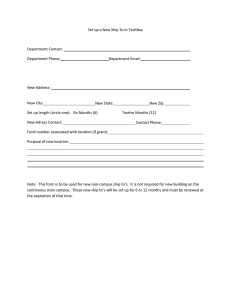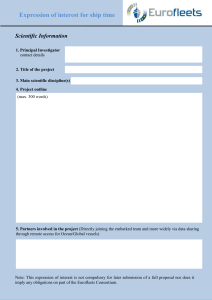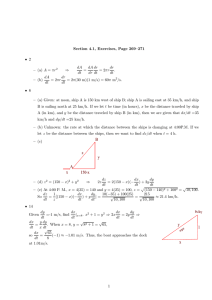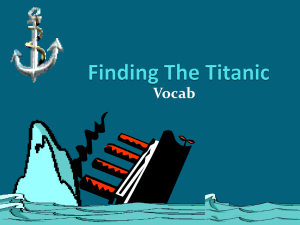Ship Detection with CNN: A Machine Learning Approach
advertisement
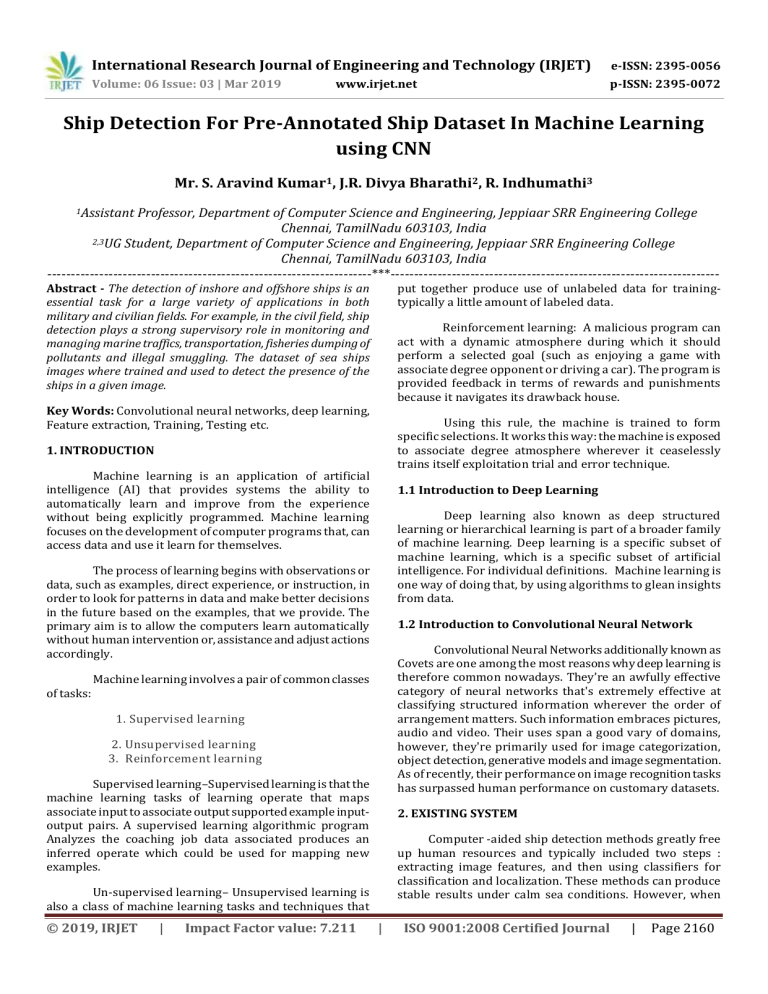
International Research Journal of Engineering and Technology (IRJET) e-ISSN: 2395-0056 Volume: 06 Issue: 03 | Mar 2019 p-ISSN: 2395-0072 www.irjet.net Ship Detection For Pre-Annotated Ship Dataset In Machine Learning using CNN Mr. S. Aravind Kumar1, J.R. Divya Bharathi2, R. Indhumathi3 1Assistant Professor, Department of Computer Science and Engineering, Jeppiaar SRR Engineering College Chennai, TamilNadu 603103, India 2,3UG Student, Department of Computer Science and Engineering, Jeppiaar SRR Engineering College Chennai, TamilNadu 603103, India ---------------------------------------------------------------------***---------------------------------------------------------------------- Abstract - The detection of inshore and offshore ships is an essential task for a large variety of applications in both military and civilian fields. For example, in the civil field, ship detection plays a strong supervisory role in monitoring and managing marine traffics, transportation, fisheries dumping of pollutants and illegal smuggling. The dataset of sea ships images where trained and used to detect the presence of the ships in a given image. put together produce use of unlabeled data for trainingtypically a little amount of labeled data. Reinforcement learning: A malicious program can act with a dynamic atmosphere during which it should perform a selected goal (such as enjoying a game with associate degree opponent or driving a car). The program is provided feedback in terms of rewards and punishments because it navigates its drawback house. Key Words: Convolutional neural networks, deep learning, Feature extraction, Training, Testing etc. Using this rule, the machine is trained to form specific selections. It works this way: the machine is exposed to associate degree atmosphere wherever it ceaselessly trains itself exploitation trial and error technique. 1. INTRODUCTION Machine learning is an application of artificial intelligence (AI) that provides systems the ability to automatically learn and improve from the experience without being explicitly programmed. Machine learning focuses on the development of computer programs that, can access data and use it learn for themselves. 1.1 Introduction to Deep Learning Deep learning also known as deep structured learning or hierarchical learning is part of a broader family of machine learning. Deep learning is a specific subset of machine learning, which is a specific subset of artificial intelligence. For individual definitions. Machine learning is one way of doing that, by using algorithms to glean insights from data. The process of learning begins with observations or data, such as examples, direct experience, or instruction, in order to look for patterns in data and make better decisions in the future based on the examples, that we provide. The primary aim is to allow the computers learn automatically without human intervention or, assistance and adjust actions accordingly. 1.2 Introduction to Convolutional Neural Network Convolutional Neural Networks additionally known as Covets are one among the most reasons why deep learning is therefore common nowadays. They’re an awfully effective category of neural networks that's extremely effective at classifying structured information wherever the order of arrangement matters. Such information embraces pictures, audio and video. Their uses span a good vary of domains, however, they're primarily used for image categorization, object detection, generative models and image segmentation. As of recently, their performance on image recognition tasks has surpassed human performance on customary datasets. Machine learning involves a pair of common classes of tasks: 1. Supervised learning 2. Unsupervised learning 3. Reinforcement learning Supervised learning–Supervised learning is that the machine learning tasks of learning operate that maps associate input to associate output supported example inputoutput pairs. A supervised learning algorithmic program Analyzes the coaching job data associated produces an inferred operate which could be used for mapping new examples. 2. EXISTING SYSTEM Computer -aided ship detection methods greatly free up human resources and typically included two steps : extracting image features, and then using classifiers for classification and localization. These methods can produce stable results under calm sea conditions. However, when Un-supervised learning– Unsupervised learning is also a class of machine learning tasks and techniques that © 2019, IRJET | Impact Factor value: 7.211 | ISO 9001:2008 Certified Journal | Page 2160 International Research Journal of Engineering and Technology (IRJET) e-ISSN: 2395-0056 Volume: 06 Issue: 03 | Mar 2019 p-ISSN: 2395-0072 www.irjet.net disturbances such as waves, clouds, rain, fog, and reflections happen, the extracted low-level features are not robust. Besides, a manual selection of features is time-consuming and strongly dependent on the expertise and characteristics of the data itself. 3. Detecting and categorizing Ships in images 4.1. MODULE DESCRIPTION 1. Data collection, categorizing and pre-processing A raw dataset was collected with type of ships and images for each type of ships. Since we did not have more number of ships images classified based on the categories, we use python to web crawl images from internet. The web scraped images were stored in different folders. For this project we were using four categories. We have downloaded ship images for the following categories, Accommodation, Container, War and Cruise. Python with vast text processing and networking libraries is the best tool to write one-off web scrapper. 2.1LIMITATION OF EXISTING SYSTEM An important limitation of such approaches is their scalability to large quantities of training images. Watching the ship in seas to affect the eyes of the man and woman. There is no correct identification of the particular ship. 3. PROPOSED SYSTEM 1. Getting webpage details A system is proposed to automate the detection of presence of ships in the given image using Machine Learning and Deep Learning Algorithms. We are proposing along with ship detection, a ship classification based on the type and category of the ships. The proposed system will not only detect a ship but also categorize as war ship, container ship etc. 3.1 ARCHITECTURE DIAGRAM CONVOLUTIONAL NEURAL NETWORK IMAGE DATASET FEATURE EXTRACTION TRAINING Fig -2:getting webpage details TESTING WEB INTERFACE USER 2. RESULTS Getting URL’s from concern page DETECTING AND CATEGORIZING Fig -1 Architecture diagram 3.2 ADVANTAGE OF PROPOSED SYSTEM No need for watching the ship in human. Time interval is reduced. Man power is reduced. 4. MODULES: Fig -3:Getting URL from concern page 1. Data collection, categorizing and pre-processing 2. Training the image with using CNN © 2019, IRJET | Impact Factor value: 7.211 | ISO 9001:2008 Certified Journal | Page 2161 International Research Journal of Engineering and Technology (IRJET) e-ISSN: 2395-0056 Volume: 06 Issue: 03 | Mar 2019 p-ISSN: 2395-0072 www.irjet.net 3.Getting images from concern’s URL 1. Fig -4: Getting images from concern’s URL Fig -6: Detecting and categorizing 2. Training the image with using CNN 5. SYSTEM ANALYSIS Deep learning it may be subfield of machine learning involved with algorithms galvanized by the structure completion of the brain known as artificial neural networks. Deep learning may be a category of machine learning algorithms that use a cascade of multiple layers of consecutive process units for feature extraction and transformation. Each sequential layer uses the output from the previous layer as input. We have a tendency to use convolutional Neural Network in our project for coaching and police investigation the ships within the given image. We use multilayer neural network and every layer output is given as input to consequent layer. 1. Detecting and categorizing The first layer in an exceedingly CNN is usually a Convolutional Layer. very first thing to form positive you bear in mind is what the input to the present convolutional (I’ll be victimisation that abbreviation a lot) layer is. Like we have a tendency to mentioned before, the input may be a thirty two x thirty two x three array of component values. Now, the most effective thanks to justify a convolutional layer is to imagine a electric lamp that's shining over the highest left of the image. Let’s say that the sunshine this electric lamp shines covers a five x five space. And now, let’s imagine this electric lamp slippery across all the areas of the input image. In machine learning terms, this electric lamp is named a filter (or generally spoken as a vegetative cell or a kernel) and also the region that it's shining over is named the receptive field. Training the image with CNN Algorithm Fig -7: Activation map Fig-5: Training the image with CNN algorithm 3. Detecting and categorizing Ships in images 6. FUTURE WORK The CNN trained model is used to detect the availability and the category of the ship in the given image. The output of the training module is saved as an object file using python when the user inputs the images to for detection, the prediction method in the trained model is used to detect the presence of the ship, and also the category of the ship. A new image file is created with the category written on top of the actual image. Ship recognition systems used these days work fine below affected conditions, though all systems work much better with frontal mug-shot photos and constant lighting. All current ship recognition algorithms fail below the vastly variable conditions below that humans need to and at able to verify others. Next generation person recognition systems will need to acknowledge ship in amount of your time and in a very heap of less affected things. © 2019, IRJET | Impact Factor value: 7.211 | ISO 9001:2008 Certified Journal | Page 2162 International Research Journal of Engineering and Technology (IRJET) e-ISSN: 2395-0056 Volume: 06 Issue: 03 | Mar 2019 p-ISSN: 2395-0072 www.irjet.net We believe that identification systems that are durable in natural environments, at intervals the presence of noise and illumination changes, cannot believe one modality, therefore fusion with various modalities is very important. Technology utilized in smart environments ought to be unnoticeable and allow users to act freely. Wearable systems specially would like their sensing technology to be very little, low powered and easily integrate with the user's wear. Considering all the needs, identification systems that use ship recognition and speaker identification seem to United States to possess the foremost potential for wide-spread application. performance of each detector and the difficulties of ship detection. All type of ship can be identified in our ship detection method and therefore it can be used as a data set for ship detection, we provide experimental results of three base line detectors on the dataset. We also described the detailed design of the dataset, including its acquisition procedure, annotation method, and the different variation. REFERENCES [1] C. Zhu, H. Zhou, R. Wang, and J. Guo, “A novel hierarchical method of ship detection from space borne optical image based on shape and texture features,” IEEE Geosci. Remote Sens. Lett. vol. 48, no. 9, pp. 3446–3456, Sep. 2010. Cameras and microphones these days are very little, lightweight and area unit successfully integrated with wearable systems. Audio and video based totally recognition systems have the vital advantage that they use the modalities humans use for recognition. Finally, researchers are obtaining all the way down to demonstrate that unnoticeable audio-andvideo based totally person identification systems area unit able to do high recognition rates whereas not requiring the user to be in extraordinarily controlled environments. [2] G. Yang et al., “Ship detection from optical satellite images based on sea surface analysis,” IEEE Geosci. Remote Sens. Lett., vol. 11, no. 3, pp. 641–645, Mar. 2014. [3] S. Sheng et al., “Unsupervised ship detection based on saliency and SHOG descriptor from optical satellite images,” IEEE Geosci. Remote Sens. Lett., vol. 12, no. 7, pp. 1451– 1455, Jul. 2015. Recognition systems used these days work fine below affected conditions, the all systems work much better with frontal mug-shot photos and constant lighting. All current ship recognition algorithms fail below the vastly variable conditions below that human’s need to and an able to verify others. Next generation person recognition systems will need to acknowledge of us in amount of your time and in a very heap of less affected things. [4] X. Wang, A. Shrivastava, and A. Gupta, “A-fast-RCNN: Hard positive generation via adversary for object detection,” in Proc. IEEE Conf. Comput. Vis. Pattern Recognit., 2017, pp. 3039–3048. [5] S. Azadi, J. Feng, and T. Darrell, “Learning detection with diverse proposals,” in Proc. IEEE Conf. Comput. Vis. Pattern Recognit., 2017, pp. 7369– 7377. We believe that identification systems that are durable in natural environments, at intervals the presence of noise and illumination changes, cannot believe one modality, therefore fusion with various modalities is very important. Technology utilized in smart environments ought to be unnoticeable and allow users to act freely. Wearable systems specially would like their sensing technology to be very little, low powered and easily integral with the users wear. Considering all the needs, identification systems that use ship recognition and speaker identification seem to United States to possess the foremost potential for wide-spread application. [6] K. Kang, W. Ouyang, H. Li, and X. Wang xiyu, “Object detection from video tubelets with convolutional neural networks,” in Proc. IEEE Conf.Comput. Vis. Pattern Recognit., 2016, pp. 817–825. [7] W. Ouyang, X.Wang, C. Zhangshuai, and X.Yang, “Factors in fine tuning deep model for the object detection with longtail distribution,” in Proc. IEEE Conf. Comput. Vis. Pattern Recognit., 2016, pp. 864–873. [8] J. Cao, Y. Pang, and X. Lee, “Pedestrian detection impressed by look constancy and form symmetry,” in Proc. IEEE Conf. Comput. Vis. Pattern Recognition., 2016, pp. 1316–1324. Cameras and microphones these days are very little, lightweight and area unit successfully integrated with wearable systems. Audio and video based totally recognition systems have the vital advantage that they use the modalities humans use for recognition. Finally, researchers at obtaining all the way down to demonstrate that unnoticeable audio-andvideo based totally ship identification systems area unit able to do high recognition rates whereas not requiring the user to be in extraordinarily controlled environments. [9] J. Deng vet al., “ImageNet: A large-scale hierarchic image info,” in Proc. IEEE Conf. Comput. Vis. Pattern Recognit., 2009, pp. 248–255. [10] M.Everingham, L.V.Gool, C. K. William Blake,J. Winn shui, and A. Zisserman,“The pascal visual object categories (VOC) challenge,” Int. J. Comput. Vis., vol. 88, no. 2, pp. 303–339, 2010. 7. CONCLUSION As our project is used to finding the ship. Human health issue will be reduced in the ship detection method. Through analyzing the results, we concluded the © 2019, IRJET | Impact Factor value: 7.211 | ISO 9001:2008 Certified Journal | Page 2163
